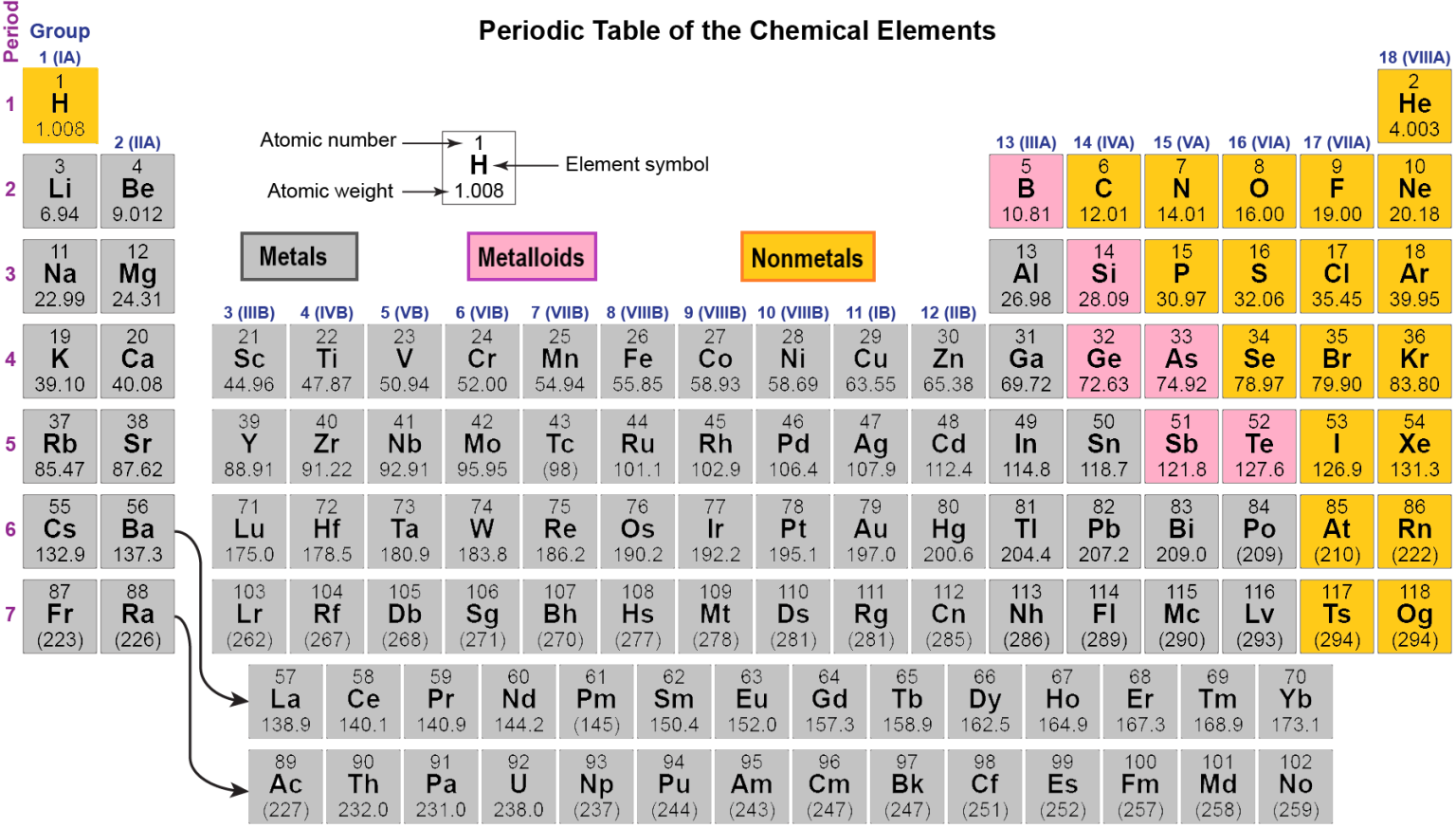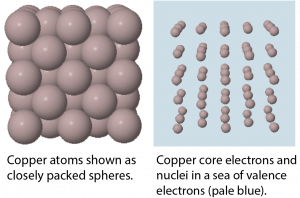D5.2 Metals
Based on iron’s boiling point of 3135 K (2862 °C), the forces between iron atoms must be much greater than just LDFs. What you have already learned about atomic structure, effective nuclear charge, and valence electrons can be used to make sense of the much larger forces that attract iron atoms, as well as atoms of other metals.
Metals, which include most of the elements in the periodic table (figure below), have characteristic macroscopic properties: they conduct heat and electricity well when they are solids or liquids; they have lustrous (metallic-looking) solid surfaces; and they deform, rather than shatter, when hammered (they are malleable). Many metals are hard, quite strong, and useful as construction materials. What gives rise to these characteristics?

Metallic substances are made of atoms whose valence electron(s) can be removed with relatively low quantities of energy, that is, elements with relatively low ionization energies. Valence electrons of metals experience lower effective nuclear charge than valence electrons of nonmetals. Hence, metals tend to form positive ions and nonmetals tend to form negative ions.
In a metallic solid, atoms are packed closely (Figure: Models of Solid Copper). One model describes solid metals at the atomic scale as atoms surrounded by mobile valence electrons—a so-called “sea” of electrons. Each “atom” consists of the nucleus and core electrons; that is, a positively charged ion that has lost all of its valence electrons. The loosely-bound valence electrons are shared (delocalized) among many different atoms. Coulombic attractions between the sea of shared valence electrons and the metal ions is known as metallic bonding. The strength of metallic bonding increases as the number of valence electrons shared in the electron sea increases.

Because the valence electrons are delocalized over many metal atoms, if one atom moves relative to others, the attractions between valence electrons and atomic cores remain, that is, metallic bonding is not specific to a particular direction. This characteristic accounts for many of the observed physical properties of metals.
Consider these boiling points for metals:
| Metal | Boiling point |
| K | 759 °C |
| Ca | 1484 °C |
| Sc | 2836 °C |
| Ti | 3287 °C |
| V | 3407 °C |
Apply the model of metallic bonding you have just learned to
- Explain the trend in boiling points of the five metals.
- Predict the trend in hardness of the five metals and explain how you made the prediction.
- Explain why solid and liquid metals conduct electricity.
After writing explanations in your course notebook, compare your work with this.
The five metals are in the fourth row of the periodic table on the left. Boiling point values increase going across the table with K < Ca < Sc < Ti < V. The number of valence electrons for each metal atom is this: K 1; Ca 2; Sc 3; Ti 4; V 5. Increasing number of valence electrons together with increasing charge for the positive ions that share the valence electrons should lead to increased attractions among valence electrons and atomic cores (positive ions). Increased attraction means that a higher temperature is required for the atoms to have sufficient energy to overcome attractions of their neighbors and separate on going from liquid to gas. Therefore more valence electrons should correlate with higher boiling points.
More valence electrons produce stronger metallic bonding. The harder a substance is the more difficult it is to make a dent in the surface. Making a dent means moving one part of the substance away from another and that should be more difficult the stronger the attractions are among the atoms. Therefore hardness should increase from left to right across the periodic table: K softer than Ca softer than Sc softer than Ti softer than V. (For example, the Mohs hardness values for these metals are: K (0.4), Ca (1.75), Sc (-), Ti (6.0), V(7.0).)
If the valence electrons are not associated with any specific metal atom (atomic nucleus and core electrons), the valence electrons should be able to move easily from one atom to another. If an electric potential difference (voltage) is applied to the metal by attaching the positive and negative terminals of a battery to the metal in two places, electrons can move away from the negative terminal and toward the positive terminal, producing electric current. This applies to any situation where atoms are close together; that is, to solid and liquid metals.
Please use this form to report any inconsistencies, errors, or other things you would like to change about this page. We appreciate your comments. 🙂 (Note that we cannot answer questions via the google form. If you have a question, please post it on Piazza.)

